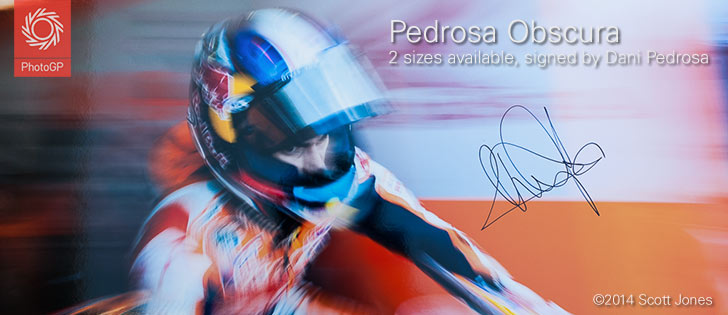Photography Tip: Night Shooting
In response to my invitation to ask questions for my upcoming MotoGP Stories presentation, Raw Challenge regular Glenn Hakkers sent in the question below about the photo above. As this question is of a more technical nature than I usually include in the MotoGP Stories presentation, I thought I’d do Glenn the courtesy of replying here in a PHOTO.GP article.
Glenn wrote:
“My question for you is: Do you need different settings and equipment for night shooting like the race in Qatar? What do you do to get the pictures just as good as the others that are shot in daylight?
I picked the photo of the second corner of the Qatar Race, where you can see that the colours and sharpness of the image are great.
For me as a amateur photographer, I think you need a longer shutter speed and larger aperature to get enough light on the sensor, but with a longer shutterspeed, there is a risk that your image will be blurry. And you can’t go too high on your ISO, because you would get too much noise.”
My answer is:
Ideally you’d like to use settings similar if not identical to what you’d use in daylight in on order to control depth of field and motion blur in your images. So all the observations in your question are correct, Glenn, except that in this situation, you needn’t go ‘too high’ on your ISO to get good results. You just need to go ‘high enough.’
With modern gear, you don’t need anything special to get get good low light performance. Modern DSLRs have ISO capability to handle the relatively (compared to day time) low light without too much noise. The image you chose to ask about, for example, was shot on a Nikon D4 at ISO 5000. Here is the EXIF information for that image:

(The sharp-eyed among you may notice that I had the Exposure Compensation set to -1/3, and to be honest I don’t recall why I’d done that.)
Sure,the Nikon D4 is a pro camera with Nikon’s best technology, but even in the prosumer levels of Nikon’s and Canon’s product lines, the high ISO performance is amazingly good.
In addition to good camera body performance in low light conditions, noise can also be reduced with software. The software noise reduction built into Adobe Lightroom is quite effective as of Lightroom 5.

Here is the image before Noise Reduction has been applied in Lightroom:

You may notice a slight loss of sharpness in the version with the noise reduction. This is a tradeoff for reducing noise with software. But as with many technologies, as noise reduction algorithms improve, the loss of sharpness falls so I expect this to get better as time passes.
The high ISO performance is really the key to being able to shoot with normal settings at Losail. So it’s much less of a challenge in 2014 than it was in 2009, the first year I went to Qatar, because the technology has come a long way.
In 2009 I switched from Canon to Nikon specifically because I knew I was going to Qatar to shoot at night. Back then the Nikon D3 and D700 offered high ISO performance significantly better than any other DSLRs, so I sold my Canon gear and have been with Nikon ever since. Canon has since caught up and I believe the high ISO performance of each brand is comparable.
Even given the current high ISO technology (and ‘high ISO’ in this case is relative to the present day, since even ISO 25,600 will probably seem very ordinary a few years from now), you still want to shoot at the lowest ISO possible in a given situation. Ideally there would be no noise in the image at all, so even if performance at ISO 5000 is pretty good, ISO 3200 would be a bit better, ISO 1600 better still. At Losail I’m always trying to keep my ISO setting as low as the given location allows. Since some corners are brighter than others, I’m constantly adjusting the ISO just as I’m adjusting the shutter speed and aperture settings to suit the type of image I want to create.
But in fact this is no different from shooting on a cloudy day, when the light is always changing slightly, and you’re adjusting shutter speed and aperture to suit the type of image you want. If the clouds cover the sun while you want to use a faster shutter speed, you’ll need to increase the ISO even though it’s day time.
So returning to your question, Glenn, if your camera body is an older one limited to, say, ISO 1600, you’d have a difficult time using shutter speeds you’re familiar with in the low light of Losail at night. But if your body was purchased within the past 2-3 years, you’d probably have no trouble at all.
Thanks for the question!
![]()
 To see more Motorsports Photography Tips, check out this page!
To see more Motorsports Photography Tips, check out this page!










Please sign in or register to contribute a comment or question.